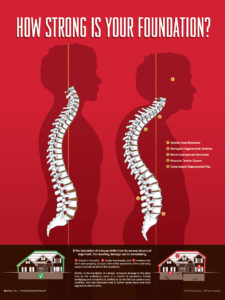TL;DR – Research shows that Neuro-Structural Chiropractic care is really safe and really effective for migraines.
Your head is pounding, and just the lights in the room make it worse. You feel nauseated and even a whisper sounds like a megaphone pressed up against your ear. Yep…you have a migraine.
To put it bluntly – migraines suck. Let’s take a peek at the numbers. In America alone, there are 38 million people who suffer from migraines. Almost 1 in 5 women get migraines. Nine out of Ten people with migraines have missed work, with 59% reporting their work was cut in half! Migraines cost between $5.6 and $17.2 BILLION in productivity EVERY YEAR in the United States. (1)
Now, most of the people reading this, already know what a migraine is, because they are here because they have them. In case you are just reading because you want to learn something new, let’s get a quick overview of what exactly is a migraine. Migraines are severe headaches with specific symptoms. A migraine has four stages. Stage One: Prodrome Phase – the time preceding the migraine which typically has indicators such as food cravings, irritability, drowsiness, among others Stage Two: Aura Phase – this is typically a visual disturbance, but can also manifest as another sensory issue. Stage Three: Attack Phase – this is the acute phase of a migraine that can last from 4-72 hours. Finally, Stage Four: Postdrome Phase – this is the typically the 1 to 2 days following a migraine in which a person is recovering from the Attack Phase and is characterized by feeling drained or fatigued. (2)
Migraine diagnoses are not as clear cut as a positive or negative blood test or imaging scan. Rather, a migraine diagnosis comes from a combination of a patient’s history, symptoms and examination findings. (3) Unfortunately, not all migraines manifest the same way. Some migraine sufferers don’t have auras, or any distinct Prodrome Phase. This can make a migraine diagnosis a drawn out affair while symptoms are monitored, various testing is performed, and sometimes multiple medications are experimented with.
(Let’s take a second here to post this disclaimer – I am NOT a medical doctor. I am NOT making any recommendations FOR OR AGAINST medical treatments. For medical advice consult a medical doctor)
Some good news…sort of…Imitrex™ (Sumatriptan Succinate) has been shown in studies to be generally effective for migraine symptoms, and typically works within about 2 hours of taking it. The less great news is overuse can cause – you guessed it – headaches. The side effects of the medication are not pleasant either. Pain or tightness in the chest, jaw, throat, or neck; feeling of pressure or heaviness in your body; numbness/tingling in your fingers and toes; feeling hot or cold in your hands and feet; and feeling weak, drowsy, or tired are all COMMON side effects. In fact, feeling drowsy is so common that the medication warns against performing any task that requires you to be fully alert. (4) Hmm..the medication sounds almost as debilitating at the condition itself! Don’t misunderstand me – I’m not criticizing the medicine, the people using it, or the doctors prescribing it. Migraines really are horrible events and getting relief is a good thing. The question though, is this the only option?
I’m so glad you asked! No – there is preventative migraine medication. Prevention sounds great, but there are a few qualifiers first. The official recommendation to be considered for migraine prevention is having frequent attacks – meaning more than 1 per week (3). While this still applies to 2-3 million people, that leaves 35-36 million people out of luck (1). I am going to use this time to repeat the previous disclaimer – I am NOT a medical doctor and I am NOT making any recommendations FOR OR AGAINST medical treatments. For medical advice consult a medical doctor. Okay, now that I have made that perfectly clear I will give you a brief table regarding preventative medications for migraines.
| Types of Medications | Medication Class | Side Effects |
| Blood Pressure Medication | Beta Blockers | Fatigue, Depression, Nausea, Insomnia, Dizziness |
| Blood Pressure Medication | Calcium Channel Blockers | Weight gain, Constipation, Dizziness, Low BP |
| Antidepressant | Tricyclic Antidepressant | Weight gain, Dry mouth, Sedation, Decreased libido |
| Antidepressant | SSRI/SSNRI | Weight gain or loss, decreased libido |
| Anticonvulsant | Anticonvulsant | Weight gain or loss, Sedation, Skin rash |
| Serotonin Antagonist | Serotonin Antagonist | Blood vessel spasm, Abdominal scarring (very rare) |
The way that these drugs are used for migraine prevention can range from a single medication to a combination of 3 or more. (3)
Now what…are there any other options? The answer is definitely yes – let’s talk about Neuro-Structural Chiropractic Correction. (If you need some background information on what Neuro-Structural Chiropractic Correction is suggest you read this.)
So let’s start with the most basic question – do people even go to chiropractors for migraines? The article, “Evidence-based guidelines for the chiropractic treatment of adults with headaches” found that chiropractic is both a safe and effective treatment for migraines (as well other types of headaches) (6) A survey found that many chiropractors even carry what is known as a Heavy Migraine Caseload. (7) If you suffer from migraines and you aren’t getting adjusted, you are missing out on a well established treatment which has been shown to be both safe and effective.
Okay, so we know that the medication options for migraines have been shown to be pretty effective, but they have some less than desirable side effects. What could I expect for side effects with a chiropractic approach? Well, the news is…pretty good actually. A study focused entirely on the sides effects of chiropractic adjustment and migraine sufferers found that the most common side effect was local tenderness after the adjustment, with the second most common side effect being tiredness the day of the adjustment. The study also found that no serious or severe side effects were observed! (8)
Okay, so we have seen that a lot of people see chiropractors for migraines and the side effects are pretty minimal, so how effective is the treatment? The answer here is also pretty good. One study focusing on the structural realignment of the top bone in a person’s neck (C1) was associated with decreased migraine frequency, improved quality of life scores, and reduced migraine related disability! (9) Another study comparing medicinal interventions, chiropractic, and sham treatments found that the chiropractic adjustment group did better than the medicinal group at 3, 6, and 12 month follow-ups following intervention. Also migraine duration and intensity were reduced more with chiropractic adjustment. (10)
So for a quick recap, we can see that there are a lot of people who suffer from migraines and a few different treatment options for those people. One treatment option that offers reduced frequency, duration, and intensity of migraines, while having minimal side effects – none of which were described as serious or severe is chiropractic care. So, then why is this article about Neuro-Structural Chiropractic Correction and not just chiropractic care? Well that answer lies in yet another study. The study examined x-ray findings and people with tension-type headaches aka cervicogenic and migraines. The results were pretty overwhelming – 97% had a significant x-ray finding! In fact, 9 out of 10 women in the study had a significant reduced, absent, or reversed curve in their neck. (11) That is a pretty great example of why Neuro-Structural Chiropractic Correction is what we choose to focus on at our office. Changes to the structure of your spine are often associated with significant and and debilitating symptoms. Getting rid of pain is great, but changing the structure allows the body to actually return to normal biomechanics and physiological function, and still gets rid of the pain along the way.
- https://migraine.com/migraine-statistics/
- https://www.mayoclinic.org/diseases-conditions/migraine-with-aura/multimedia/migraine-aura/vid-20084707
- https://www.mayoclinic.org/diseases-conditions/migraine-headache/diagnosis-treatment/drc-20360207
- https://migraine.com/migraine-treatment/imitrex/
- https://americanmigrainefoundation.org/understanding-migraine/preventive-treatments/
- https://www.ncbi.nlm.nih.gov/pubmed/21640251
- https://www.ncbi.nlm.nih.gov/pubmed/29202816
- https://www.ncbi.nlm.nih.gov/pubmed/28324697
- https://www.ncbi.nlm.nih.gov/pubmed/26783523
- https://www.ncbi.nlm.nih.gov/pubmed/27696633
- https://www.ncbi.nlm.nih.gov/pubmed/1342581

